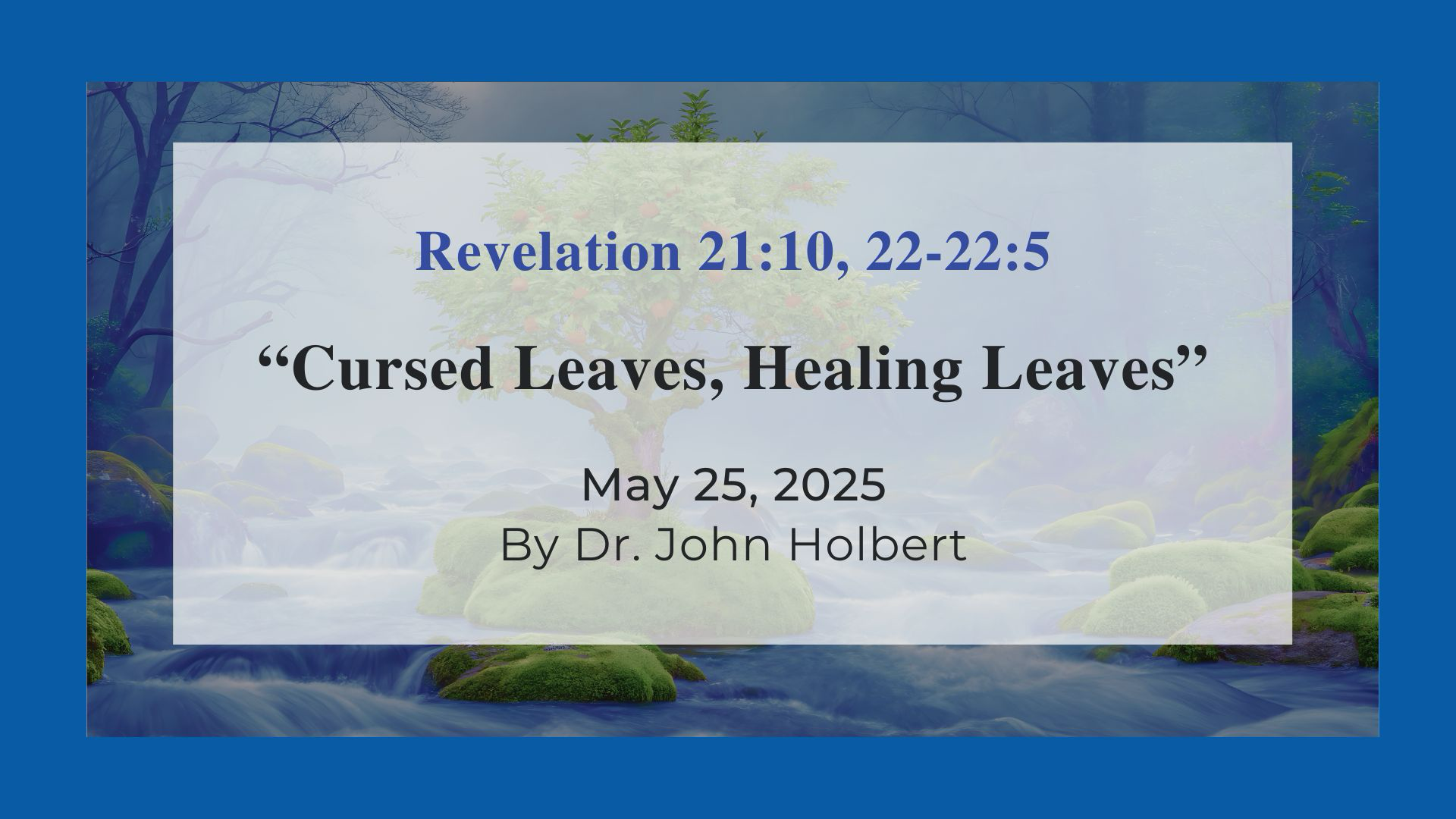Cursed Leaves, Healing Leaves - Reflections on Revelation 21:10, 22-22:5, Easter 6, Year C
by John C. Holbert on Friday, April 4, 2025

John now moves to conclude his startling narrative. He offers to the reader nothing less than a grand portrait of the heavenly city of God and the Lamb, a city that is not stuck in some faraway place above the sky but is found on the earth. Not only that, all in the city, indeed the entire redeemed human community, may now look God right in the face (Rev.22:4), no longer fearful of death upon seeing God directly. The splendid city, festooned with precious gems, made of pure gold, founded on a layer of pearls, paved with crystal, is John’s way of suggesting that here is the place all will eventually go, and that it is a city that is always “coming down out of heaven from God” (Rev.21:10). Here again John uses the Greek continuous present tense, reminding his readers that this city is perpetually descending to the earth, but visible only to those who follow the slain Lamb. Yet, it turns out that that includes everyone! In fact, the inhabitants of the city are not simply drawn from all nations; to the contrary, they are the nations and kings of the earth, those same kings and nations who made war on the Lamb (16:14; 17:18; 18:9; 19:9; 20:8), those nations destroyed in the great eschatological battle (19:21; 20:9)! But now these same kings and nations bring their glory into the New Jerusalem, “the splendor and wealth of the nations.” Thus, in this final vision all peoples and nations and languages and tongues are found in the city. This vision in the end fulfills the universalist prophecies of the Hebrew Bible.
In the midst of all this technicolor beauty and magnificence, I want to focus attention on an amazing connection between a specific image found here and a similar image found many centuries in the past in the book of Genesis. John obviously is using the imagery of the prophet Ezekiel as the base of his own reflections on his vision of the Heavenly City. Ezekiel, that 6th-5th century BCE Hebrew prophet, supposedly transported in a vision from an exile in Babylon back to the city of Jerusalem, sees in graphic detail a brand new city (Ez.40:1-47:12). Like John in Revelation, Ezekiel is guided through the new city by an angel carrying a measuring rod (Ez.40:3-43:12), and that is not the only similarity between the two prophet’s descriptions of a new Jerusalem. John obviously knew the work of Ezekiel well.
But what catches my eye is the portrayal of the “river of the water of life, flowing from the throne of God and of the Lamb” (Rev.22:1). In Ezekiel, the water of a river flows from the sanctuary of God, the refurbished temple, but in Revelation’s city there is no temple at all; the river flows directly from the throne of God and the Lamb. But, more interestingly, “on either side of the river stands a tree of life, yielding twelve crops of fruit, …, and the leaves of the tree were for the healing of the nations” (Rev.22:2). Genesis, of course, speaks also of rivers flowing from Eden, of fruit, of leaves of the tree of life and the tree of the knowledge of good and evil, a certain euphemism for the knowledge of everything. At the end of the famous garden story of Gen.3, the reader is left with a picture of stolen fruit, a lying couple, tossed from the garden, which is guarded by a terrifying angel, armed with a whirling sword, to bar the way back to the garden and its tree of life. John’s vision reverses that picture completely.
John here sees the river flowing from God’s throne, a river that contains life again for all in the city. And here the tree of life, forbidden to the couple in the garden due to their disobedience against God, is now readily available in the fruits growing copiously on both sides of the river, and growing year-round for the delight and delectation of the inhabitants of the city. But perhaps most importantly, “the leaves of the tree are for the healing of the nations.” In Genesis, in obvious hilarity, the couple, convinced by the snake that they would “be God” (or “be like God” in the more familiar translation), snatch the fruit, and in the later attempt to cover their nakedness, now a problem revealed when “their eyes are opened,” “sew fig leaves” to cover themselves. Every ancient Israelite would know all too well what fig leaves feel like—they are like number two-grade sandpaper! You would not have a fig leaf on too long if you used them for underwear! Those leaves were hardly for anyone’s healing; they are a symbol for the separation from God experienced by the pathetic first couple. But now, in the New Jerusalem, the leaves are for healing, not for separation. In the city of God and the Lamb all find a united community where fruit is for all and leaves are for healing.
In this way, the biblical story provides a superb arc to its readers. It moves from a couple removed from the garden God had given to them, because they abused the fruit and misused the leaves, to a brand new “garden,” a New Jerusalem, where fruit is available to all, where the river contains the water of life for all, and where the leaves of the tree are only for healing. John has rung fresh changes on an ancient tale and has given to all of us new hope for a community of the beloved, found together in the city of God and the Lamb. John bids us all become followers of the Lamb so that we may finally see this vast and wonderful city and find our place in it.
